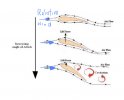denislawsbackheel
Well-Known Member
- Joined
- 28 May 2008
- Messages
- 27,383
- Team supported
- We went to Rotherham…
I like EasyJet’s hands free service.
£7 gets priority at check in, no queuing, bag in the hold, line up with priority boarding, no bun fight with all the others trying to get the bags in the overhead lockers, just board at my convenience with my iPad and book in a small bag.
£7 gets priority at check in, no queuing, bag in the hold, line up with priority boarding, no bun fight with all the others trying to get the bags in the overhead lockers, just board at my convenience with my iPad and book in a small bag.

